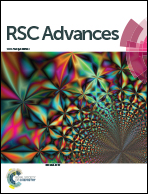An electrochemiluminescence lab-on-paper device for sensitive detection of two antigens at the MCF-7 cell surface based on porous bimetallic AuPd nanoparticles†
Abstract
In this work, a novel paper-based electrochemiluminescence (ECL) immunosensor for ultrasensitive and selective detection of corresponding antigens on living cells was developed employing AuPd nanoparticles as a signal amplifier and macroporous Au-paper working electrodes (Au-PWE) for efficient cell capture. The porous AuPd nanoparticles are chosen as label nanomaterials due to their controllable three-dimensional porosity and peroxidase like activity, large surface area, superior conductivity, and favorable catalytic activity to H2O2 which could enhance the ECL intensity for signal amplification. CdTe QDs and luminol groups as ECL probes were linked with the antibodies to recognize the corresponding antigens on the cell surface and the wide potential range between them compared to conventional antigens sensors could prevent interfacing with each other. Using this strategy, human carcinoembryonic (CEA) and alphafetoprotein (AFP) antigens on living MCF-7 cancer cells as models were quantified serially through a potential scanning way. Significantly, this strategy may be quite promising in cancer early diagnosis due to the excellent analytical performance.



 Please wait while we load your content...
Please wait while we load your content...